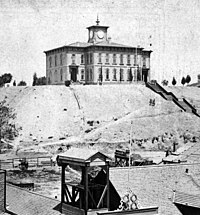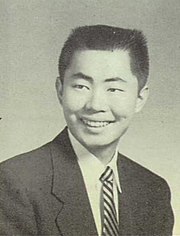Los Angeles High School
The attendance boundary consists of a contrasting spectrum of economic diversity ranging from affluent Hancock Park and Lafayette Square to the low-income, densely populated immigrant community of Koreatown.Early buildings commissioned to house the Los Angeles High School were among the architectural jewels of the city, and were strategically placed at the summit of a hill, the easier to be pointed to with pride.The two-story wooden structure was so big and grand, the finest school south of San Francisco at that time, with classic lines and a tower with a clock in it, that people traveled from miles around to see it.[6] In 1879, a natural science club, the Star and Crescent Society, was founded at LAHS and consisted then of the entire student body.He lost a considerable amount of money because of his elaborate preparations, including the high wooden trestle which carried the building over the intersection of Temple and Fort Street.Finally, they got it moved up to its new location on Sand Street,[7] where LAHS students and faculty remained until the second high school was built a few years later.The city neglected to remove the remains and clear away the grave sites and some LAHS students in the 1890s thought it was "fun" to sit and eat their lunch while they leaned against a tombstone.As Belmont students and parents protested the transfers, an alternative plan provided that 12 persons be assigned to the senior and junior high schools in the six attendance areas to carry out the program.To insure a permanently beautiful vista for their contemplation, and to honor classmates who had fallen in World War I, the students purchased the land across the street for the creation of a tree-filled memorial park.[16][17][18][19] Actual student government was instituted at LAHS in the early 1900s, eliminating one of the main reasons for Star and Crescent's existence.Meanwhile, as the size of the student body increased over years, the lower grades were successively dropped from Star and Crescent until by 1935 only seniors were members.Star and Crescent probably disappeared after World War II, but it is difficult to determine the exact year since no one at the school today can say when it ended.Efforts spearheaded by the Alumni Association, founded in 1876, to repair and preserve the iconic structure were opposed by certain commercial interests,[citation needed] who lobbied for its demolition, and finally decisively thwarted when it was gutted by a fire of mysterious origin.[25] Neighborhoods zoned to LAHS include: Brookside, Harvard Heights, Koreatown, Lafayette Square, and Little Ethiopia, and portions of Hancock Park and the Pico-Union District.








List of Los Angeles Unified School District schoolsLos AngelesCoordinatesPublicMagnetLos Angeles Unified School DistrictCIF LA City SectionRomanshigh schoolSouthern CaliforniaWestern Association of Schools and CollegesLos Angeles Community College DistrictWest Los Angeles CollegeLos Angeles Trade–Technical CollegeLos Angeles City CollegeSanta Monica Collegeinner-cityMid-WilshireHancock ParkLafayette SquareimmigrantKoreatownTitle Iuniversity preparatoryintegrationseniorPoundcake HillLoyola High SchoolBroadwayTemple StreetSan Franciscotransomsnatural sciencesciencede factostudent governmentHollywood FreewayHill StreetFort Moore Hillstreet carsLong Beach earthquakedowntownSunset BoulevardCesar Chavez AvenueBroadway TunnelLos Angeles City High School DistrictLos Angeles City School DistrictBoard of EducationtruancyBelmont High SchoolEcho ParkFort Moore Pioneer MemorialOlympic BoulevardWorld War IWorld War IIyearbookshigh school newspapersRoom 222Sylmar earthquakeWest Adams Preparatory High SchoolFairfax High SchoolBrooksideHarvard HeightsLittle EthiopiaPico-Union DistrictKorean languageAdvanced Placement ProgramBiologyCalculus AB and BCChemistryEnglish Language and CompositionEnglish Literature and CompositionEnvironmental ScienceMacroeconomicsMicroeconomicsPsychologySpanish LanguageSpanish LiteratureStatisticsStudio Art Drawing, 2-D, and 3-DUnited States HistoryUnited States Government and PoliticsRay BradburyHarry DanningDustin HoffmanDonald PrellMel TorméMargaret Q. AdamsYda Hillis AddisLou AlmadaMel AlmadaJimmy AllenTod AndrewsJack BantaAnne BaxterScotty BeckettPauline BetzFletcher BowronLarry BrownSuper Bowl XXXCharles BukowskiJohn CageJohn P. CassidyRichard ChewFrank ChumanJohnnie CochranO. J. SimpsonLynn "Buck" ComptonBand of BrothersDA of Los Angeles CountySirhan SirhanGary ConwayLillian CopelandVernon DeanMel DurslagAileen EatonBruce EdwardsMike EvansRobert C. FarrellLouise FazendaLita GaithersTony AwardSiedah GarrettGrammyMarjorie GestringJohn M. Goddard


